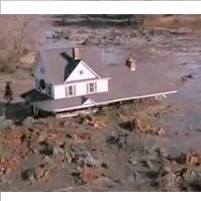Toxic Sludge in Tennessee More Radioactive Than Nuclear Waste
Wednesday, December 31, 2008

After the biggest toxic spill in U.S. history (100 times larger than the infamous 1989 Exxon Valdez oil spill), the Tennessee Valley Authority has advised residents (inaccurately) that boiling their water would remove dangerous heavy metals and make it drinkable, but the United Mountain Defense reports that people living near the plant have experienced vomiting after drinking out of their private wells. More than 1 billion gallons of coal ash broke an earthen dike in Kingston, Tennessee, and demolished 12 nearby houses on December 22. After municipal waste, coal ash is the largest source of waste in the nation, and is more radioactive than nuclear waste, according to an article in Scientific American last year. The Tennessee Valley Authority, which provides electricity to most of Tennessee and is responsible for the disaster, claimed that its preliminary tests showed that the nearby Tennessee River has not been contaminated, but the Environmental Protection Agency reported on Sunday that local water was contaminated enough that it could not be considered “drinking quality” because of high arsenic levels. The incident was preceded by at least two smaller spills in the last six years at the same site.
TVA Not Holding “Its Head Up High” (by J.J. Stambaugh, Knoxville News Sentinel)
A First Hand Account of the TVA Coal Ash Disaster in Kingston, TN (by Dave Cooper, Huffington Post)
“Empty Promise”: The Broken Federal Commitment Behind the Tennessee Coal Ash Disaster (by Sue Sturgis, Facing South)
Coal Ash Spill Revives Issue of its Hazards (by Shaila Dewan, New York Times)
Ash Spill: Two Prior Breaches at Retention Site (by Chloe White, Knoxville News Sentinel)
Flood of Sludge Breaks TVA Dike: Collapse Poses Risk of Toxic Ash (by Anne Paine and Colby Sledge, The Tennessean)
How Should the Federal Government Address the Health and Environmental Risks of Coal Combustion Waste? (Attorney Lisa Evans of Earthjustice speaks to a House subcommittee on June 10, 2008)
Coal Ash Is More Radioactive than Nuclear Waste (by Mara Hvistendahl, Scientific American)
Environmental Protection Agency (AllGov)
- Top Stories
- Unusual News
- Where is the Money Going?
- Controversies
- U.S. and the World
- Appointments and Resignations
- Latest News
- Musk and Trump Fire Members of Congress
- Trump Calls for Violent Street Demonstrations Against Himself
- Trump Changes Name of Republican Party
- The 2024 Election By the Numbers
- Bashar al-Assad—The Fall of a Rabid AntiSemite






Comments